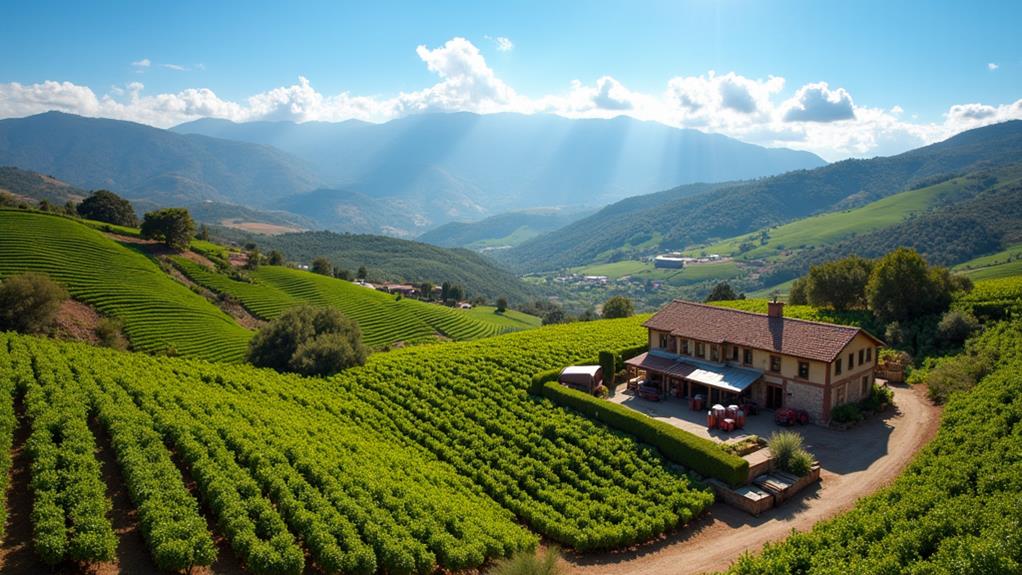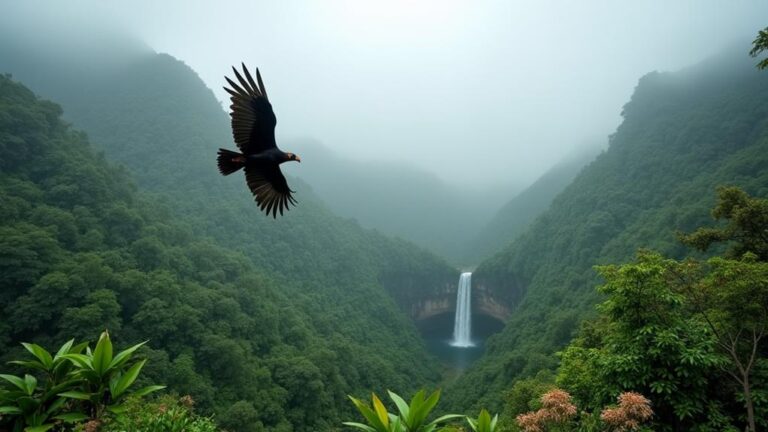You may not know that Chile is home to some of the world's oldest grapevines, with some dating back to the 18th century. These ancient vines are still producing high-quality grapes today, and they play a key role in Chile's thriving wine industry. As you explore Chilean wineries, you'll discover a mix of traditional techniques and modern innovations that set the country apart from other major wine-producing nations. But what's driving the evolution of Chile's wine scene, and how are its winemakers adapting to the challenges of climate change and shifting consumer tastes?
Contents
- 1 Key Takeaways
- 2 History of Chilean Wine
- 3 Best Wine Regions to Visit
- 4 Top Varieties of Chilean Wine
- 5 Innovative Winemaking Techniques
- 6 Chile's Wine Country Landscapes
- 7 Must-Visit Wineries in Chile
- 8 Wine Tasting and Tours
- 9 Chilean Wine and Food Pairing
- 10 Impact of Climate Change
- 11 Emerging Trends in Chilean Wine
- 12 Frequently Asked Questions
- 13 Conclusion
Key Takeaways
- Chile's wine industry dates back to the 16th century with the introduction of European grape varieties by Spanish conquistadors.
- Chile has four distinct wine country landscapes, including the Maipo Valley, Colchagua Valley, Maule Valley, and Curicó Valley.
- Chilean wineries excel in producing Cabernet Sauvignon, Carménère, Sauvignon Blanc, and Chardonnay, among other varieties.
- Innovative winemaking techniques in Chile include Sustainable Fermentation and Advanced Blending, reducing environmental impact and showcasing unique flavors.
- Visiting Chilean wineries often involves wine tasting tours, education, and exploration, with opportunities to learn about wine etiquette and pairing.
History of Chilean Wine
Chile's wine industry has a rich history dating back to the 16th century when Spanish conquistadors first introduced European grape varieties, primarily Vitis vinifera, to the region.
As you dig into the history of Chilean wine, you'll find that the Spanish settlers played a significant role in shaping the country's viticulture.
They brought with them their knowledge of winemaking techniques and grape varieties, which they adapted to the region's unique climate and soil conditions.
The early vitis introduced by the Spanish settlers thrived in Chile's Mediterranean climate, particularly in the central valley regions.
The country's isolation from the rest of the world, due to the Andes Mountains to the east and the Pacific Ocean to the west, helped to protect the vines from diseases such as phylloxera.
This, combined with the country's favorable climate, allowed Chilean wine production to flourish.
As you explore the history of Chilean wine, you'll notice that the industry experienced significant growth during the 19th century, with the establishment of large wineries and the introduction of new grape varieties.
This marked the beginning of Chile's emergence as a major player in the global wine industry.
Best Wine Regions to Visit
Visiting Chile's wine regions offers a unique opportunity to experience the country's diverse terroir firsthand.
You'll have the chance to explore wine trails that wind through scenic valleys, coastal hills, and mountainous terrain.
The Maipo Valley is a must-visit, with its well-established vineyards and wineries.
This region is known for its rich, volcanic soils and Mediterranean climate, making it ideal for producing Cabernet Sauvignon and other red varieties.
The Colchagua Valley is another region worth visiting, with its picturesque landscape and stunning vineyard architecture.
You can take a guided tour of the wineries, learning about the wine-making process and sampling some of the region's best wines.
The Colchagua Valley Wine Route is a 100-kilometer trail that takes you through some of the region's top wineries, offering breathtaking views of the Andes Mountains.
The Maule and Curicó Valleys are also worth visiting, with their unique terroir and innovative winemaking techniques.
These regions offer a glimpse into Chile's emerging wine scene, with many small, family-owned wineries producing high-quality wines.
Top Varieties of Chilean Wine
You'll find that Chilean wineries produce a diverse range of wines, with several varieties standing out for their exceptional quality.
One of the most notable is Cabernet Sauvignon, which consistently wins top wine awards and meets high grape expectations. This full-bodied red wine is characterized by its robust tannins and rich flavors of dark fruit, spices, and subtle hints of earthy undertones.
Carménère is another standout variety, known for its unique flavor profile and velvety texture. This varietal has garnered significant attention in recent years, earning numerous awards and recognition for its rich, smooth flavors of plum, blackberry, and subtle hints of chocolate.
Chilean wineries also excel in producing crisp and revitalizing white wines, particularly Sauvignon Blanc and Chardonnay.
These varieties are known for their zesty acidity and flavors of citrus, green apple, and grassy notes. When you explore the top varieties of Chilean wine, you'll discover a range of styles and flavors that cater to different tastes and preferences, making Chile an exciting destination for wine enthusiasts.
The country's unique terroir and climate allow for the production of high-quality wines that meet discerning grape expectations.
Innovative Winemaking Techniques
Forward-thinking Chilean winemakers have been pushing the boundaries of traditional winemaking techniques, incorporating innovative methods that enhance the quality and distinctiveness of their wines.
One of these methods is Sustainable Fermentation, which reduces the environmental impact of the winemaking process. This involves using energy-efficient equipment, minimizing water usage, and using natural yeast strains to reduce the need for chemical additives.
By adopting Sustainable Fermentation, Chilean winemakers can produce high-quality wines while minimizing their ecological footprint.
Another innovative technique used by Chilean winemakers is Advanced Blending. This involves using advanced software and statistical analysis to create complex blends that showcase the unique characteristics of each grape variety.
By analyzing the chemical composition and flavor profiles of different wines, winemakers can create blends that are greater than the sum of their parts. Advanced Blending allows Chilean winemakers to experiment with new flavor profiles and styles, resulting in a diverse range of wines that cater to different tastes and preferences.
This technique has enabled Chilean winemakers to stay ahead of the curve regarding innovation and experimentation.
Chile's Wine Country Landscapes
Four distinct wine country landscapes span Chile, each offering unique terroir characteristics that contribute to the country's diverse wine styles.
As you explore Chile's wine country, you'll notice the varied landscapes, which range from coastal regions to mountainous areas.
The rolling hills of the coastal regions, such as the Leyda Valley and the San Antonio Valley, provide a fertile ground for cool-climate varieties like Pinot Noir and Chardonnay.
In contrast, the mountainous regions, including the Andes and the Coastal Range, offer a more rugged terrain with steep slopes and varied soil types.
This diversity of landscapes contributes to the country's ability to produce a wide range of wine styles, from crisp and invigorating whites to full-bodied and complex reds.
The rustic charm of the countryside, with its old vineyards and traditional farming practices, adds to the allure of Chile's wine country.
As you visit these regions, you'll gain a deeper understanding of how the unique terroir characteristics shape the country's wine production.
Must-Visit Wineries in Chile
When you plan your visit to Chile's top wineries, consider the best red wine estates for their rich, full-bodied varieties.
You'll also want to explore scenic white wine vineyards that offer stunning views and crisp, revitalizing wines.
Best Red Wine Estates
Located in Chile's premier wine regions, you'll find many exceptional red wine estates worth visiting.
These wineries are renowned for producing high-quality red wines that consistently perform well in wine competitions. Their wines often fetch high prices at wine auctions, a badge of honor to their exceptional quality.
When planning your trip to Chile, consider visiting the following top red wine estates:
- Concha y Toro's Marqués de Casa Concha: This winery is considered one of Chile's top red wine producers, with their wines regularly receiving high scores from wine critics and performing well in wine competitions.
- Santa Carolina's Herencia: This historic winery has been producing high-quality red wines since the 19th century and is known for its exceptional Cabernet Sauvignon and Merlot blends.
- Viu Manent's La Capilla: This winery is located in the Colchagua Valley and is known for its full-bodied red wines, particularly its Cabernet Sauvignon and Syrah blends, which have received accolades in wine competitions worldwide.
Visiting these wineries will provide you with a deeper understanding of Chile's red wine production and an opportunity to taste some of the country's best wines.
Scenic White Wine Vineyards
Chile's scenic white wine vineyards offer a unique blend of natural beauty and exceptional wine production.
When you visit these wineries, you'll discover the picturesque vineyard scenery that showcases the country's diverse terroir. The rolling hills, verdant valleys, and breathtaking mountain backdrops create an idyllic setting for cultivating high-quality white grapes, including Chardonnay, Sauvignon Blanc, and Riesling.
Some must-visit wineries in Chile's scenic white wine vineyards include those in the Casablanca Valley, known for its crisp and revitalizing Sauvignon Blanc, and the Maipo Valley, which produces complex and oaky Chardonnay.
As you explore these vineyards, you'll notice the meticulous attention to detail that goes into cultivating the grapes, from pruning to harvesting. The winemaking techniques employed in these vineyards are designed to preserve the delicate flavors and aromas of the white grapes, resulting in wines that are both elegant and refined.
Whether you're a seasoned wine connoisseur or simply looking for a unique experience, Chile's scenic white wine vineyards are a must-visit destination.
Wine Tasting and Tours
Visiting a Chilean winery often involves more than just sampling its wines.
It's an immersive experience that combines education, exploration, and sensory delight.
As you set out on a wine tasting tour, you'll have the opportunity to learn about the winemaking process, from grape harvesting to fermentation and aging.
To get the most out of your wine tasting experience, consider the following:
1. Familiarize yourself with wine etiquette: Understand the proper way to hold the wine glass, swirl the wine, and take a sip. This will help you appreciate the wine's aroma, flavor, and texture.
2. Use your senses: Pay attention to the wine's color, clarity, and viscosity.
Swirl the wine to release its aromas, and take a sip to experience its flavors and finish.
3. Keep a wine journal: Record your impressions of each wine, including its flavor profile, acidity, tannins, and overall character.
This will help you track your progress and refine your palate.
Chilean Wine and Food Pairing
As you explore Chile's wine scene, you'll discover a rich heritage that influences the country's wine and food pairings.
You'll find that popular pairings often feature local seafood, beef, and pastries, which complement the country's renowned wine varieties.
Chile's Wine Heritage
When exploring Chilean wine, you'll discover that its wine heritage is deeply rooted in the country's rich gastronomic traditions.
This unique blend of indigenous, Spanish, and Mediterranean influences has shaped the country's wine culture and contributed to its national pride.
Chile's wine history dates back to the 16th century, when Spanish conquistadors introduced vines to the region.
The country's wine pioneers played a significant role in establishing Chile's wine industry, experimenting with various grape varieties and winemaking techniques.
Some key factors have contributed to the success of Chilean wine:
- Diverse terroir: Chile's varied geography, with its unique combinations of soil, climate, and altitude, allows for the cultivation of a wide range of grape varieties.
- Investment in technology: Chilean winemakers have adopted modern winemaking techniques, enabling them to produce high-quality wines.
- Government support: Chile's government has implemented policies to promote the wine industry, providing financial support and infrastructure development.
These factors have helped establish Chile as a major player in the global wine market, with many of its wines receiving international recognition and acclaim.
Popular Food Pairings
Chile's wine heritage has created a foundation for exceptional food pairings.
When it comes to wine and cheese, you'll find that Chilean wines complement a variety of cheeses. A glass of Carmenère pairs well with a rich, creamy brie, while a crisp Sauvignon Blanc complements the tangy flavors of a goat cheese.
When pairing wine with other dishes, you'll want to ponder the flavors that combine.
For example, a bold Cabernet Sauvignon pairs well with the rich flavors of a beef stew, while a light Pinot Grigio pairs well with the delicate flavors of seafood.
The key is to balance the flavors so that neither the wine nor the food overpowers the other.
In Chile, you'll also find that many wines are paired with traditional dishes such as pastel de choclo (corn pie) and chupe de mariscos (seafood stew).
The flavors of these dishes combine with the wine to create a truly exceptional culinary experience.
Regional Wine Specialties
Within Chile's distinct wine regions, you'll discover unique specialties that showcase the country's diverse terroir.
As you explore Chilean wineries, you'll find that each region has its own distinct wine identity, shaped by factors such as climate, soil, and altitude.
This regional identity is reflected in the wine terroir, which is the combination of environmental factors that affect the flavor and character of the wine.
When it comes to regional wine specialties, certain regions excel in specific varieties.
- Maipo Valley: Known for its rich, full-bodied Cabernet Sauvignons, Maipo Valley is one of Chile's premier wine regions.
- Colchagua Valley: This region is famous for its Carmenère wines, which are known for their bright acidity and flavors of red fruit and spice.
- Casablanca Valley: With its cool climate and granite soils, Casablanca Valley is well-suited to producing crisp and invigorating white wines, particularly Chardonnay and Sauvignon Blanc.
Impact of Climate Change
Rising global temperatures, driven by climate change, are substantially altering the Chilean wine industry's terroir.
You'll notice that the warmer conditions are changing the way grapevines grow and produce fruit. Rising temperatures, particularly in the ripening phase, affect the balance of sugars and acids in the grapes. This shift impacts the flavor profile and overall quality of the wines.
As a result, winemakers must adapt their viticulture practices to mitigate the effects of climate change.
Shifting harvests are another consequence of climate change. Warmer temperatures cause grapes to ripen earlier, which can lead to premature harvests.
This change in timing can be challenging for winemakers, as they must adjust their harvesting schedules to guarantee ideal grape quality. In some regions, the earlier harvests may also lead to increased risk of frost damage, as the vines are more susceptible to frost during the critical budding phase.
Emerging Trends in Chilean Wine
As the Chilean wine industry navigates its evolving landscape, you're witnessing the emergence of several trends that are reshaping its viticulture and winemaking practices.
The Chilean pioneers who spearheaded the country's wine revolution are now embracing innovative techniques to stay ahead of the curve.
This shift towards modernization is driven by consumer demands for high-quality, unique wines.
Some of the key emerging trends in Chilean wine include:
- Organic and biodynamic winemaking: Many Chilean wineries are adopting sustainable practices to reduce their environmental footprint and produce wines that reflect their unique terroirs.
- Experimentation with new grape varieties: Winemakers are exploring the potential of lesser-known grape varieties, such as País and Carignan, to create distinctive and complex wines.
- Investment in technology: Chilean wineries are investing in cutting-edge technology, such as precision viticulture and advanced winemaking equipment, to improve efficiency and quality.
These trends are driving a new wave of innovation in the Chilean wine industry, positioning it for continued growth and success in the global market.
Frequently Asked Questions
Can I Ship Wine From Chile Back to My Home Country?
When shipping wine internationally, you'll need to navigate customs regulations and shipping logistics. You'll require proper documentation and compliance with both the shipping and receiving countries' regulations to certify a smooth, duty-paid delivery to your home.
Are Chilean Wineries Accessible for People With Disabilities?
Imagine a traveler traversing an obstacle course, symbolizing the challenges people with disabilities face. You'll find many wineries, globally, now offering accessible paths. Chilean wineries are no exception, with growing disability awareness, they're becoming more inclusive.
Can I Visit Chilean Wineries With My Children?
Visiting wineries with kids can be fun, as many offer kid-friendly activities and family outings. Chilean wineries are no exception, providing playgrounds, games, and wine-free tastings, making them suitable for family trips and outings.
Do I Need to Book Wine Tours in Advance?
Imagine strolling through lush vineyards, the sun shining down. When exploring wine country, you'll find that booking wine tours in advance is recommended, especially for same-day or last-minute visits, as wine enthusiasts flock during tourist season.
Are Chilean Wineries Open Year-Round for Visitors?
You'll typically find wineries open year-round, but hours may vary. Peak season usually offers extended hours, while off-season hours are often reduced, so it's best to check the winery's schedule before planning your visit.
Conclusion
As you sip a glass of Chile's renowned Cabernet Sauvignon, imagine the threads of tradition and innovation weaving together like the intricate vines that blanket the Maipo Valley. Just as a master winemaker carefully blends flavors to create a rich, full-bodied wine, Chile's wineries are masterfully merging heritage and experimentation, yielding a vibrant tapestry of flavors that's gaining international recognition – with exports increasing by 20% annually.









